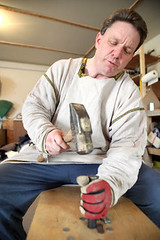
PREV ARTICLE
NEXT ARTICLE
FULL ISSUE
PREV FULL ISSUE
DAWSON LEWIS, MEDIEVAL MONEYER OF PIERRE, SD
Thanks to Coin Update for the link to this article about a history reenactor from South Dakota who plays the role of a moneyer, creating imitations of 10th-century coins. Be sure to watch the video online.
-Editor
The hobby began as a desire to demonstrate for his son’s fourth-grade class, as they were studying about Rome, how the ancients made coins. After a few rough attempts to reproduce money on his own, a friend connected him with somebody in the Society for Creative Anachronism, a group dedicated to recreating now-obsolete processes, which Lewis joined soon after. The rest, as they say, is history – well, re-created history. “In the SCA people specialize in different crafts and stuff, and my geeky thing is the coins,” Lewis said. Lewis makes them the way a coin-maker – technically a “moneyer” – living in 10th-century England would, although he works in inexpensive aluminum rather than the silver and gold of his medieval counterparts. To mint the faux money, Lewis hammers a sheet of metal until it reaches a desired thinness, and then cuts out individual circles. Lewis does admit to cheating a bit, using a coin punch rather than doing it by hand. The metal circles, or blanks, are then put between a top and bottom die. The dies are handmade by Lewis, who must painstakingly punch letters and forms onto them in reverse so the image on the coin isn’t backward. When the top die is struck with a hammer, the metal blank is pressed, creating the final product. That method – hammering one at a time – is basically how coins were made from the time they were invented around 600 B.C. until A.D. 1500, Lewis said. For the past several years Lewis has shown what he calls his “experimental archaeology” at various venues, including the Living History Fair in Brookings and the Midwest Viking Festival in Fargo, N.D. Recently he struck commemorative coins to honor the 40th Latin banquet in Pierre and its founder, Jay Mickelson. By his estimates Lewis has made six or seven dies, and has individually struck several thousand coins. But he and a group of fellow enthusiasts once struck upward 10,000 coins to give away to school children for a single event. “Striking coins is kind of like eating potato chips – it’s hard to do just one,” he said.
To read the complete article, see:
Pierre man strikes coins using medieval methods
(www.capjournal.com/news/pierre-man-strikes-coins-using-medieval-methods THE BOOK BAZARREWayne Homren, Editor The Numismatic Bibliomania Society is a non-profit organization promoting numismatic literature. See our web site at coinbooks.org. To submit items for publication in The E-Sylum, write to the Editor at this address: whomren@gmail.com To subscribe go to: https://my.binhost.com/lists/listinfo/esylum All Rights Reserved. NBS Home Page Contact the NBS webmaster 
|
